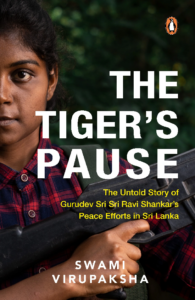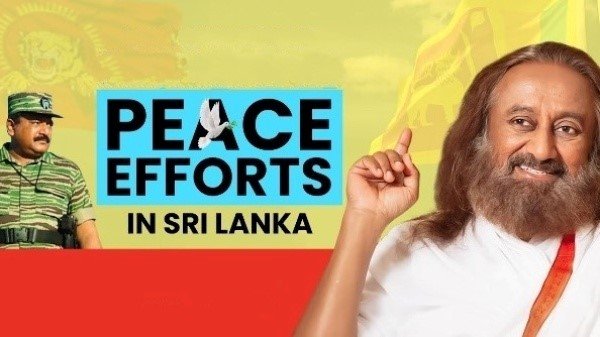The current crisis in Sri Lanka makes us wonder where Sri Lankan Tamils would be now if Prabhakaran had settled for peace at some point. At the beginning of the Fourth Eelam War that destroyed him and his organization, he said the Sri Lankan government was just not genuinely interested in talking peace.
In the Sri Lankan ethnic conflict, just like in Israel-Palestine, middle ground is hard to find. The Jewish narrative and the Palestinian narrative, too, are simply irreconcilable. Solid facts, research and analysis back both sides. Rational thinking is the basis of their positions. In the Tamil-Sinhalese conflict, reason drove both sides to war. As Sri Sri Ravi Shankar, founder of The Art of Living, says, war is the worst act of reason.
Both sides had reason to wage war in a country where the idea of a shared nationhood is not widely shared. For instance, the theme of the museum in the Kandy Temple of Tooth is the history of Tamil raids on the temple. Paintings show how the Buddha’s bodily remnant had the mystical power to beat back the marauders through hundreds of years.
The LTTE suicide squad, Black Tigers, was the last Tamil raid party. In 1998, three Black Tigers drove an explosive laden truck into the entrance of the temple and detonated the bomb. A separate section in the museum is devoted to the LTTE attack. In May of 2009, as thousands of innocent Tamils were being killed, Colombo erupted in jubilation over the end of the war.
In the Tamil-Sinhalese conflict, reason drove both sides to war. As Sri Sri Ravi Shankar, founder of The Art of Living, says, war is the worst act of reason.
From Rajiv Gandhi to the Norwegians, many had tried to broker peace. But none could be a dispassionate bridge between the two sides. In 2004, when Swami Virupaksha was sent by his mentor Sri Sri Ravi Shankar to Sri Lanka to teach yoga and meditation to provide trauma relief to the survivors of the Tsunami, Sri Sri told him to be a bridge between the Tamils and the Sinhalese.
In his recent book, The Tiger’s Pause, Virupaksha has recounted his experiences there and narrated Sri Sri’s attempts to mediate between the two sides – to be a bridge. The sequence of events is gripping like in a novel, only this was reality and the deaths and destruction were all too real.
Virupaksha recounts how during one of Sri Sri Ravi Shankar’s visits to Sri Lanka, the wife of Mahinda Rajapaksa, then the prime minister, was coincidentally at the airport lounge to meet a friend. Shiranthi saw Sri Sri and sent an aide to find out who he was. Upon learning about Sri Sri Ravi Shankar, she invited him to their residence.
Mahinda learned The Art of Living breathing techniques and Virupaksh often has him recounting how they gave him peace of mind. Later, Mahinda, as President, asked that Sri Sri mediate when the Fourth Eelam War was breaking out.
Meanwhile, Sri Lankan Tamils who were in The Art of Living in Canada had asked that Sri Sri should do something to bring peace in their homeland. One of the volunteers there, Anandam, who had links with the LTTE leadership, set up a meeting with Prabhakaran. V Rudrakumaran, attorney with LTTE links who today continues to actively represent the Tamil cause, met Sri Sri in New York and asked that Sri Sri help bring the EU’s and other nations’ goodwill to the LTTE. Sri Sri told him peace would be a pre-requisite, says Tiger’s Pause.
Mahinda’s message to Sri Sri was that he and Prabhakaran should talk directly, man to man. He arranged for a helicopter to take Sri Sri to Omanthai where government territory ended and LTTE land began. The UN official manning the no-man’s land after the government checkpost told Sri Sri and his aides about how a cow had been blown to bits by a mine a few days ago on the road to Tiger territory.
On September 21, 2006, the International Day of Peace, the party walked the kilometer-long stretch unharmed and entered the Tiger’s den. The peacemakers spent several hours in Killinocchi waiting for Prabhakaran. LTTE cadres accompanying them were constantly on the phone. One cadre asked that Sri Sri should stay overnight but that was not the plan. Before leaving, Sri Sri gave many gifts to the cadres. He gave a white shawl and asked them to give it to Prabhakaran with a message that to win a war, one needed skill (yukthi) more than weapons and force.
Going back and forth, Virupaksha explains how people, situations and events built up towards a tragic destiny. Looking back they even seem inevitable. Much later, when Virupaksha was doing trauma relief programmes for the internally displaced after the end of the war, he learned what happened on that September day in Killinocchi.
The intelligence unit headed by Pottu Amman had planned to keep Sri Sri hostage to force a temporary truce so the LTTE could draw attention and beef up their defenses and supplies. The LTTE’s peace negotiator and civilian Thamizhchelvan felt this was a very bad idea and would bring disrepute globally.
One thinking among the top leadership was that the LTTE was in a strong position and were going to win, so why accept peace. The intelligence unit headed by Pottu Amman had planned to keep Sri Sri hostage to force a temporary truce so the LTTE could draw attention and beef up their defenses and supplies. The LTTE’s peace negotiator and civilian Thamizhchelvan felt this was a very bad idea and would bring disrepute globally. Nadesan, the police chief, too thought it was a bad idea.
Prabhakaran’s instruction to Pottu Amman was that no harm should come to Sri Sri Ravi Shankar if he was kidnapped. Though the kidnapping plan was not executed, Pottu Amman won the day when he said Sri Sri’s calming presence would turn Prabhakaran into a “lamb”. And that if Prabhakaran surfaced to meet Sri Sri, Indian surveillance equipment would track him on the way and tell the Sri Lankan government, making him a sitting duck. Virupaksha later scoffs at this fear.

Sri Sri Ravi Shankar with the leader of the Marxist guerillas in Colombia, Ivan Marquez
Virupaksha feels in retrospect that even if the LTTE had indeed taken Sri Sri hostage and Prabhakaran had got to interact with him, things may have been different. He recalls Sri Sri’s meetings with Ivan Marquez, the head of the Marxist guerrillas in Colombia, that facilitated peace negotiations between them and the government.
In less than 200 pages, Virupaksha shows that he is like a seasoned reporter relying largely on primary sources and his own observations to build the narrative. The moving stories of a woman the LTTE had sent to spy on them and who was later “disappeared”; the vignettes describing the denouement in May of 2009 when Tamils literally waded through the bodies of their kin in the Nandhikadal lagoon to cross over to the government side; and Virupaksha’s self-deprecatory humour bring the story to life.
When things were almost lost, Nadesan, by then the LTTE head, called Sri Sri who was in Switzerland and asked for his intervention to ensure the killings stopped. The message was relayed through the Indian government to Mahinda who by then knew complete victory was at hand and refused the belated peace offer. A surrendering Nadesan was reportedly shot and killed in cold blood.
But what if Prabhakaran had sued for peace and accepted something lesser than a separate Eelam in 2006? History is full of ifs and buts, and no one can guess the answer.
In one of his visits to India when the fourth phase of the war was happening, Virupaksha met Sri Sri who showed him what he had brought to give as a gift to Prabhakaran in Killinocchi. It was a small silver “Vel”, the weapon of Lord Murugan that vanquishes enemies. But who all were Prabhakaran’s enemies, really?











